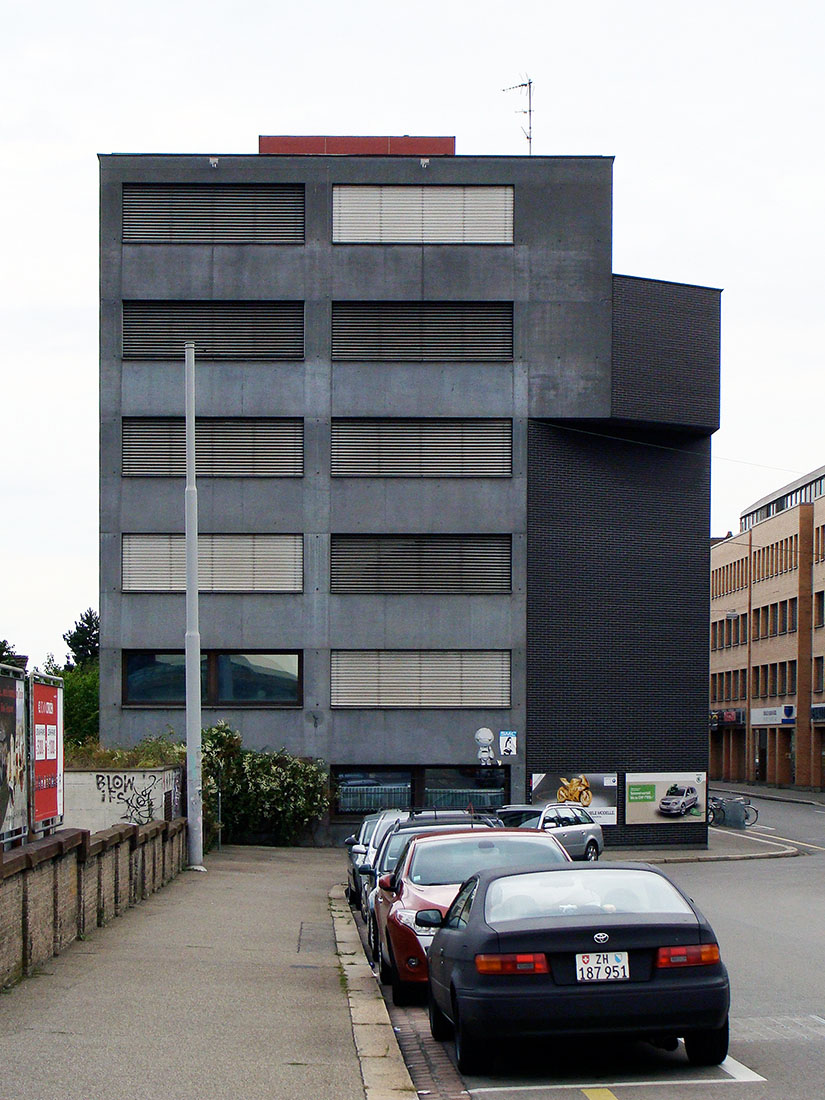 |
 |
 |
 |

Office Building Hochstrasse
Hochstrasse 31, Basel
1985 - 1988
The Administration Building Hochstrasse, designed by Diener & Diener, is located near the main station of Basel, directly adjacent to the railway lines.
This nineteenth-century neighbourhood had become increasingly attractive for service industries, although the facades are stained
by the rust from the railway. In this case, the building was commissioned by a bank, which asked for high-end office spaces.
This office building with six stories follows exactly the established building lines. The figure of the building is established by three
deviations from a straightforward cube. Along the curve of the street is a diagonal cut-out of the corner of the main volume. Above
this triangular void is a cantilevered volume with another, smaller, diagonal cut-out. And the top-floor is set back from the main street front.
These interventions on the monolithic block result in sculptural qualities and in a strong figure at the short side of the building, which at the
same time is the prominent termination of a closed row of houses, consisting mainly of residential buildings. A lower level with conference rooms,
lit by skylights and facing the railway tracks, is concealed by an existing retaining wall. All facade surfaces which are cut by
the mentioned interventions are clad with vitrified black clinker bricks. The walls of the diagonal cut-outs are windowless and contrast with the rest
of the volume, which is generously fenestrated. This monolithic building has a rather robust appearance and incorporates the rough spirit of this situation,
which is considered an allusion to the industrial originis of the site. The exposed concrete facades of the building are of a rather dark colour,
which is the consequence of adding four percent iron oxide. This anthracite colour refers to the railroad brake dust. The exposed concrete facade
is constructed as a cavity wall, which combines thermal insulation with a massive exterior shell of 18 cm thickness. These walls encounter the ground
without mediation of a plinth. On a first sight the building appears very simple, the refined details become obvious on a second viewing. The whole
facade was cast by using large plywood panel formwork with a Bakelite finish. The reveals are sandblastet and the window sills are prefabricated.
Another special feature are the windows, all of them have the same form and size. The frames, consisting of two wings, are made of bronze
and have 1:2 proportions.
This nineteenth-century neighbourhood had become increasingly attractive for service industries, although the facades are stained
by the rust from the railway. In this case, the building was commissioned by a bank, which asked for high-end office spaces.
This office building with six stories follows exactly the established building lines. The figure of the building is established by three
deviations from a straightforward cube. Along the curve of the street is a diagonal cut-out of the corner of the main volume. Above
this triangular void is a cantilevered volume with another, smaller, diagonal cut-out. And the top-floor is set back from the main street front.
These interventions on the monolithic block result in sculptural qualities and in a strong figure at the short side of the building, which at the
same time is the prominent termination of a closed row of houses, consisting mainly of residential buildings. A lower level with conference rooms,
lit by skylights and facing the railway tracks, is concealed by an existing retaining wall. All facade surfaces which are cut by
the mentioned interventions are clad with vitrified black clinker bricks. The walls of the diagonal cut-outs are windowless and contrast with the rest
of the volume, which is generously fenestrated. This monolithic building has a rather robust appearance and incorporates the rough spirit of this situation,
which is considered an allusion to the industrial originis of the site. The exposed concrete facades of the building are of a rather dark colour,
which is the consequence of adding four percent iron oxide. This anthracite colour refers to the railroad brake dust. The exposed concrete facade
is constructed as a cavity wall, which combines thermal insulation with a massive exterior shell of 18 cm thickness. These walls encounter the ground
without mediation of a plinth. On a first sight the building appears very simple, the refined details become obvious on a second viewing. The whole
facade was cast by using large plywood panel formwork with a Bakelite finish. The reveals are sandblastet and the window sills are prefabricated.
Another special feature are the windows, all of them have the same form and size. The frames, consisting of two wings, are made of bronze
and have 1:2 proportions.
